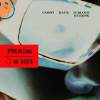
More than enough column inches have arguably now been dedicated to the whole copyright dispute between Swift and her former label Big Machine, so I don’t feel any need to wade into that fray here. However, the fact that she’s been spurred into rerecording a chunk of her back-catalogue affords students of record production a series of fascinating comparative ‘old vs new’ case-studies to ponder. And this fan-favourite song is as good a place as any to delve into such comparisons, I suppose.
In terms of spectral balance, the old version is a bit of 2012 pop time-capsule, with much less deep bass than the new version and a strident forwardness to the upper midrange of the vocals, guitars, and cymbals that promotes cut-through on cheap mass-market playback hardware, but which also grates a bit on the ear if you crank the volume. In a sense, this move stands to reason from the perspective of a much more established artist who doesn’t need such teen-focused mix translation to make an impact.
But, by the same token, shouldn’t ‘moving with the times’ also have meant taking a more modern attitude to the loudness processing? I mean, the new version has had an extra 2dB headroom squished out of it for loudness purposes, which seems odd in an era where loudness normalisation is now pretty much the norm for streaming. New: play_arrow | get_app Old: play_arrow | get_app Furthermore, if you make the effort to compare the two mixes under loudness-normalised conditions, the new version, despite its capacious bass, begins to sound a bit limp by comparison with its predecessor – gutless guitars, powerless snare… Even the vocal seems a little hollow and stranded. But don’t take my word for it – have a listen for yourself. New (-16dBLUFS): play_arrow | get_app Old (-16dBLUFS): play_arrow | get_app And even if I bring the two mixes more into the same spectral ballpark (no, not Kevin Costner’s…) using a bit of dynamic EQ, the loudness-matched comparison still feels less flattering to my ears. New (-16dBLUFS): play_arrow | get_app Old with dynamic EQ (-16dBLUFS): play_arrow | get_app
It just doesn’t really make sense. Unless… OK, let’s do a little thought experiment! Let’s say I’ve been hired to rerecord one of Taylor Swift’s classic records, but I’m struggling to get my mix sounding as powerful and upfront as the original version – after all, Taylor was already a star back in 2012, so had A-list personel working for her then too. Would I:
- admit to Ms Swift that my new version sounds a bit limp, and I’m not sure how to remedy that?
- push the loudness of my mix a couple of decibels louder than the original, thereby relying heavily on loudness bias to win her over instead, confident in the knowledge that she (like most artists) would be extremely unlikely to loudness-match the files while comparing them for herself?
Now, irrespective of whether my little daydream bears any resemblance to reality, this kind of scenario is, I think, one of the big reasons why heavy loudness processing remains in widespread use within the music industry, despite the dwindling rationale as far as consumer listening situations are concerned. You can loudness-normalise the streaming services all you want, but that won’t affect the mix/master files that engineers routinely send to clients over email or file-transfer services. As such, is it any surprise so many engineers still seek to protect their bottom line against potential loudness bias by hammering their mixes into the end-stops before delivery?










